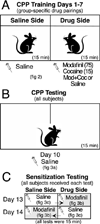Interactions between modafinil and cocaine during the induction of conditioned place preference and locomotor sensitization in mice: implications for addiction
- PMID: 22963989
- PMCID: PMC4528911
- DOI: 10.1016/j.bbr.2012.07.039
Interactions between modafinil and cocaine during the induction of conditioned place preference and locomotor sensitization in mice: implications for addiction
Abstract
Modafinil is a wake-promoting drug effective at enhancing alertness and attention with a variety of approved and off-label applications. The mechanism of modafinil is not well understood but initial studies indicated a limited abuse potential. A number of recent publications, however, have shown that modafinil can be rewarding under certain conditions. The present study assessed the reinforcing properties of modafinil using conditioned place preference and locomotor sensitization in mice. Experiment 1 examined a high dose of modafinil (75 mg/kg) as well as its interactions with cocaine (15 mg/kg). Cocaine alone and modafinil co-administered with cocaine induced sensitization of locomotor activity; modafinil alone showed little or no locomotor sensitization. Animals given modafinil alone, cocaine alone, and modafinil plus cocaine exhibited a strong and roughly equivalent place preference. When tested for sensitization using a low challenge dose of modafinil, cross-sensitization was observed in all cocaine-pretreated mice. Experiment 2 examined a low dose of modafinil that is similar to the dose administered to humans and has been shown to produce cognitive enhancements in mice. Low dose modafinil (0.75 mg/kg) did not produce conditioned place preference or locomotor sensitization. Together, these results suggest that modafinil has the potential to produce reward, particularly in cocaine addicts, and should be used with caution. However, the typical low dose administered likely moderates these effects and may account for lack of addiction seen in humans.
Copyright © 2012 Elsevier B.V. All rights reserved.
Conflict of interest statement
The authors have no conflicts of interest and did not receive funding from the makers of modafinil.
Figures




Similar articles
-
Addictive potential of modafinil and cross-sensitization with cocaine: a pre-clinical study.Addict Biol. 2011 Oct;16(4):565-79. doi: 10.1111/j.1369-1600.2011.00341.x. Epub 2011 Jul 25. Addict Biol. 2011. PMID: 21790900
-
Modafinil reinstates a cocaine conditioned place preference following extinction in rats.Behav Brain Res. 2009 Dec 1;204(1):250-3. doi: 10.1016/j.bbr.2009.05.028. Epub 2009 May 29. Behav Brain Res. 2009. PMID: 19482046 Free PMC article.
-
Psychostimulant-like discriminative stimulus and locomotor sensitization properties of the wake-promoting agent modafinil in rodents.Pharmacol Biochem Behav. 2010 Jun;95(4):449-56. doi: 10.1016/j.pbb.2010.03.006. Epub 2010 Mar 25. Pharmacol Biochem Behav. 2010. PMID: 20346966 Free PMC article.
-
Modafinil and its structural analogs as atypical dopamine uptake inhibitors and potential medications for psychostimulant use disorder.Curr Opin Pharmacol. 2021 Feb;56:13-21. doi: 10.1016/j.coph.2020.07.007. Epub 2020 Sep 11. Curr Opin Pharmacol. 2021. PMID: 32927246 Free PMC article. Review.
-
Are There Prevalent Sex Differences in Psychostimulant Use Disorder? A Focus on the Potential Therapeutic Efficacy of Atypical Dopamine Uptake Inhibitors.Molecules. 2023 Jul 7;28(13):5270. doi: 10.3390/molecules28135270. Molecules. 2023. PMID: 37446929 Free PMC article. Review.
Cited by
-
Modafinil, an atypical CNS stimulant?Adv Pharmacol. 2024;99:287-326. doi: 10.1016/bs.apha.2023.10.006. Epub 2023 Nov 22. Adv Pharmacol. 2024. PMID: 38467484 Free PMC article.
-
Participation of Dopamine D1 and D2 Receptors in the Rapid-Onset Behavioral Sensitization to Modafinil.Front Pharmacol. 2019 Mar 11;10:211. doi: 10.3389/fphar.2019.00211. eCollection 2019. Front Pharmacol. 2019. PMID: 30914950 Free PMC article.
-
Modafinil as a catecholaminergic agent: empirical evidence and unanswered questions.Front Neurol. 2013 Oct 7;4:139. doi: 10.3389/fneur.2013.00139. Front Neurol. 2013. PMID: 24109471 Free PMC article. Review.
-
MDMA and memory, addiction, and depression: dose-effect analysis.Psychopharmacology (Berl). 2022 Mar;239(3):935-949. doi: 10.1007/s00213-022-06086-9. Epub 2022 Feb 18. Psychopharmacology (Berl). 2022. PMID: 35179622 Free PMC article.
-
Psychostimulants and cognition: a continuum of behavioral and cognitive activation.Pharmacol Rev. 2013 Dec 16;66(1):193-221. doi: 10.1124/pr.112.007054. Print 2014. Pharmacol Rev. 2013. PMID: 24344115 Free PMC article. Review.
References
-
- Bastuji H, Jouvet M. Successful treatment of idiopathic hypersomnia and narcolepsy with modafinil. Progress in Neuropsychopharmacology and Biological Psychiatry. 1988;12:695–700. - PubMed
-
- Cephalon FDA Approved Labeling Text for NDA 20-717/S-005 & S008. Provigil® (modafinil) Tablets [C-IV] 2004 Approved 23-Jan-2004.
-
- O’Connor A. Wakefulness finds a powerful ally. New York Times. 2004
-
- Beracochea D, Celerier A, Peres M, Pierard C. Enhancement of learning processes following an acute modafinil injection in mice. Pharmacology Biochemistry and Behavior. 2003;76:473–479. - PubMed
Publication types
MeSH terms
Substances
Grants and funding
LinkOut - more resources
Full Text Sources

